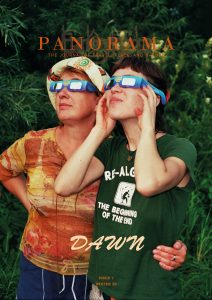“They smile, and move inside; the colours fade
Ringing my head; they seat themselves, and stare.
So I must learn that these, the learners come
To teach me something of my destiny;”
– Vincent Buckley, “Late Tutorial”
I am teaching Jhumpa Lahiri’s “The Boundary” to a class of undergraduate engineering students. For many of them, English is a language they are made to slip into once they enter the English classroom – necessitated by the course, necessitated also by their knowledge that while I understand Tamil, I cannot speak it like them. I find myself searching for ways to cross the boundaries the story imposes on my audience. It is a longish story for my students whose attention spans have been cut short by Instagram reels and youtube shorts; at 4 in the afternoon, my class is an interlude before they trudge their way to a more important engineering class at 5:30. Lahiri’s story is a reflection on living life as a poor teenage immigrant in a touristy rural hill town – of finding yourself living at the boundaries of more privileged experiences. Unlike students from other engineering batches who have travelled far and wide across India to reach here, many of the young people in my class have not travelled outside their hometown; for some of them, crossing the boundaries of their hometown is not an exciting event, but one marked with trepidation.
My own preparation for the class is not adequate – I am substituting this story for another lesson I had planned. The usual questions about familiarity with the author fall flat. As expected, they have not heard of Jhumpa Lahiri. Nor do the names of actors Irrfan Khan and Tabu, protagonists of Mira Nair’s film adaptation of Lahiri’s much acclaimed Indian English novel, ring a bell. I am dealing with a new generation of cine-goers many of who are not fans of Bollywood cinema. Our lived experiences and cultural histories do not overlap. I begin again – what is a boundary? An answer arrives– a line which divides. “Divides what?” “Places…People.” Borders and boundaries become synonymous in the imaginary and vocabulary of my students. I ask what does it feel like to be in a boundary – that marks the outer edge of a border. “Is it a comfortable place? Is it also a place of potential risk and danger?” My abstract questions draw forth thoughts that take their time to bubble up.
I ask them to remember crossing borders when they travelled on holidays. What did it feel to be the only person speaking Tamil in a place where people spoke Hindi? Did you feel weird, awkward? I press on. Did you start feeling more conscious of yourself? Did you start noticing that you were different? There are more perceptible nods at this point.
I ask them where else they have heard the term boundary. Providing a brief history lesson about cricket and colonialism, I talk of how cricket is one of the rare sports where crossing a boundary gives you points and not penalties. It is an interesting bit of trivia for the cricket buffs in my class, but does nothing to bring them closer to the story at hand.
Trying another approach, I make them read the story aloud. Buoyed by the experience of the previous public speaking class where they had made a jittery beginning at finding the possibilities in their voices, they are more eager. The voices come out louder and more confident. I ask them to guess the details about the narrator based on the clues in the text. Is she rich or poor? How old is she? Do you think she belongs to this place?
My mother can’t stand this place. Like my father, she comes from much farther away than anyone who vacations here. She hates living in the country, in the middle of nowhere. She says that the people here aren’t nice, that they’re closed.
I ask what closed means. When you are closed, what is your attitude towards things and people? Is it an attitude towards things that are different? The story is turning out to be a reflective read – there is not much action that could captivate an audience of young adults. Much of the time, the young protagonist observes and eavesdrops on the visitors she is taking care of – a family of four that looks picture-perfect compared to hers.
The mother does what I do: she sweeps the floor, cooks, washes dishes. At least once a day she hangs up the laundry. Our clothes mingle and dry on a shared line. She tells her husband, clasping the laundry basket in her arms, how happy this makes her. Since they live in the city, in a crowded apartment, she can never hang their clothes out in the open like this.
I ask how would it feel for the teenage girl to take up adult responsibilities. Why should she act as an adult when she is still a child? I ask them to focus on the image of the clothes mingling on the shared line. I supply answers where their minds are still connecting the dots. The suffocation of living in a crowded city apartment is something alien to my audience. Their hometown still offers vistas of blue skies and clothes hanging unabashedly on clotheslines. And yet, it is not tranquil enough to act as a replica for the holiday hill stay of the story.
Some are looking restless. Breaking the monotony, I ask them to talk about the kind of places they have visited or would like to visit. Where did they stay? Back in their comfort zone, they chirp happily about the trips they have been to. Some say they do not like to travel.
I ask whether boundaries could only be physical – couldn’t they also be metaphorical, mental? Aren’t there also boundaries in relationships? Weren’t there greater boundaries when they met each other as strangers on the first day of college? Didn’t those boundaries break down as they grew closer? Friends exchange reminiscent smiles and we get back to the story.
I realize how much the guests like this rural, unchanging landscape, how much they appreciate every detail, how these things help them think, rest, dream. When the girls pick blackberries, staining the pretty dresses they’re wearing, the mother doesn’t get mad at them. Instead she laughs. She asks the father to take a picture, and then throws the dresses in the wash.
I ask them to define the feelings the teenage girl may be experiencing. Why does she keep comparing her family to that of the guests? Is she feeling envious? Is she sad? Some hide snickers and giggles.
At the same time I wonder what they know about the loneliness here. What do they know about the days, always the same, in our dilapidated cottage? The nights when the wind blows so hard the earth seems to shake, or when the sound of rain keeps me awake? The months we live alone among the hills, the horses, the insects, the birds that pass over the fields? Would they like the harsh quiet that reigns here all winter?
I tell them how perspectives can change depending on your location. For the tourist mother, everything about the tiny hill stay is charming. But for the young girl who has lived there almost all her life and her mother, life is dull and monotonous. I ask them to recollect how it felt during the pandemic days. Wasn’t it fun initially when they did not have to go to school and could play and sleep all day? But, did it not get tiring once they got into a predictable routine and could not go out or play with friends? Did they not appreciate meeting friends again once things opened up? Many agree, but someone demurs. “I did not get tired. I am an introvert. I enjoyed staying at home and not meeting people,” he confides with a wide grin. My attempt at relating the story’s fictional experience to my class’s lived experience stammers and splutters. As the hour lengthens, the story finally picks up some pace. As the hour lengthens, the story finally picks up some pace. On the eve of their departure, the visiting family throws a party where they invite their friends from the city. They cut a cake and talk about the adventures they had in the hill town. As the young girl and her father finish off some overripe grapes, they are visited by the little girls who present them with two slices of cake and dash off before they could be thanked.
The mention of the piazza where the visitors bought the cake leads to a past revelation about the father and his decision to settle down in “the middle of nowhere.” It is the part I hope will have the most emotional effect on my class. The father gets attacked in an incident of mindless violence spurred on by anti-immigrant sentiment and the resulting injuries affect his ability to eat and speak. Shaken by the incident, the man who had always lived in cities moves to the secluded hill town where he lives without opening his mouth before strangers, either to speak or smile. Unfortunately, the student reader I have picked out to read out this bit of the story struggles with the unfamiliar words. I keep replacing readers till I get someone who can read it with some heart.
We are inching closer to the last 10 minutes of class. The more restless remind me it is almost half past five. The others are calmly waiting for the story to end. Racism and anti-immigrant sentiment are things that require time to be drawn out from history, time I do not have on my hands. If I continue, the story would die with a whimper. I am forced to pause the story in mid climax. I wonder if it would have been a better idea to end the class before I reached this part. By next week, they would have forgotten the story and what it signified. There are some boundaries I have not learned how to cross yet. They trudge out, some of them mouthing a slightly more expressive thank you. Perhaps they are thankful for a more relaxed class. A thought also pops in, could it be that they did like the story?
A week later, I take up the story again. I have to summarize it again to jog their memories. Unexpectedly though, they do remember. A student writing a retest on idioms in one corner of the classroom perks his ears, pulled in by where the story is going. Once the test is over, I ask the students to think of an idiom that describes the protagonist who constantly eavesdrops on the conversations of the adults. “A fly on the wall,” pat comes the answer from the student who had been writing his test a while ago. Considering he always looked like he would rather be elsewhere, I am pleased to find that the story has managed to cross some boundaries.
The story ends with the family saying their good byes with a promise to come back next year, promises the teenage girl takes half seriously. But there are keepsakes for her to hold on to – left overs and scraps of paper on which the tourist mother “in her faint small hand” had written “all about us.” I ask them to ponder why the story is titled the boundary.
Some of the answers paraphrase the talking points of my discussion: the boundaries created by economic status, of class, of village and city life. Many are silent, engaged with the problem of interpreting a story they have only partially understood. There are also some answers that take me by surprise, which reveal they are starting to engage with the story’s significations. Many of them empathize with the plight of the father who cannot speak and his desire to see his daughter educated. One empathizes with the narrator’s feelings towards the visiting family though her interpretation of them is different. For her, there is no envy – the girl is lonely: she just wants to make friends. Another student talks about the scene in the story where the little girls from the visiting family bring slices of cakes to the narrator’s door and dash off before she can say thank you. There is a sense of youthful optimism in their answers! More than boundaries, they are preoccupied with the attempts to cross them. I urge them to think more deeply about the story for the reading test scheduled a month away.
As the class comes to an end, I ruminate over my own boundary crossings as a teacher of literature. The boundaries the story places on an Indian audience– the sight of “the small plum trees, fig trees and olives”– will remain as alien to them as it is to me. Rooted and content in their hometown, the immigrant experiences the story narrates may stay at the boundaries of their geopolitical imagination for a while longer. Nor will I be able to make it relatable unless I get time to tell other stories – stories which would be considered dysfunctional in the Engineering English syllabus catered to improving their communication skills. Likewise, classroom conversations will inevitably reveal the boundaries of our lived experiences, the zones of palpable disconnection with no promise of overlaps. I also tell myself that there will be boundaries created by my identity and the no woman’s land of a generational gap that will only grow more difficult to cross the next time I teach this story.
A few days later, they are working on another assignment: narrating an unforgettable episode from their lives. Trying to express the diverse emotions felt on the first day of college – the sinking feeling of being a nobody in a crowd of somebodies, the crushing realization that college meant re-entering the loop of a school-like routine, the overwhelming sense of relief on locating a face that anchored you to the new surroundings– each one of them journeys into places they have not travelled before. As I watch them rack their brains, it is brought home to me that the story may have helped them cross a boundary I had not foreseen – the need to define and express emotions, however complex they may be. It dawns on me that boundaries need not always be lines that mark how far one could go; they could also be thresholds into new territories, new lived experiences, and new imaginaries.
Note:
The italicized quotes are from Jhumpa Lahiri’s story “The Boundary” which is part of the prescribed academic syllabus of the Technical English course I teach at the university.
Lahiri, J. (2018) The Boundary, The New Yorker. Available at: https://www.newyorker.com/magazine/2018/01/29/the-boundary (Accessed: 15 June 2023).










